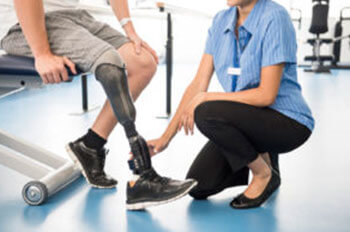
Millions of Americans have experienced some sort of lower-limb loss. Partial foot amputations (PFA) are the most prevalent, followed by toe amputations. Complications from diabetes is the most common cause for PFA. In other cases, a partial or full foot/toe amputation may be necessary if the patient has experienced a serious injury and the foot or toe cannot be restored.
After a PFA or toe amputation, the patient’s ability to stand and walk is compromised, as they do not have the necessary leverage, balance and support as they once did. A prosthetic device can restore balance and support for many patients who have experienced an amputation, and help them live full, active lives.
What is the Process of Getting a Prosthetic?
Prior to the amputation procedure, the podiatric surgeon will discuss the patient’s prognosis and treatment options post-surgery. In many cases, it may be appropriate and helpful for the patient to wear a prosthetic device to regain mobility.
After the procedure, the patient will enter the rehabilitation phase. This is a critical stage where the wound must heal and muscles need to rebuild. The patient will also learn how to care for their limb and how to compensate movements, train muscles and develop feeling in the residual limb.
Once all of this has occurred, and the patient is able to bear weight on the residual limb, they are fitted for a prosthetic that is best suited for their particular situation.
How Are Prosthetic Solutions Determined?
The patient will have a medical team, including their podiatric surgeon and a prosthetist who will collaborate in order to create a prosthetic solution. Factors taken into account include the shape and length of the patient’s residual limb, their general health, weight and height, along with their their needs, goals, and preferences.
The patient’s level of activity is also a big consideration when creating a prosthetic care plan. A patient will be given a K-level rating (from 0-4), which correlates to their predicted mobility level and helps determine which prosthesis will help them function at their desired activity level.
What Kind of PFA and Toe Prosthetics Are Available?
Today’s prosthetics are very advanced, and utilize state-of-the-art technology and components.
- Shoe Inserts. Custom shoe inserts can often help fill in areas of the foot that are missing and support the patient after a toe amputation or one that involved removing a smaller portion in the middle of the foot.
- Ankle Foot Orthosis (AFO). AFOs in combination with a shoe insert can often help a patient return to a more active lifestyle. An AFO is an orthotic brace that supports the foot and ankle, which helps improve walking patterns and helps maintain joint alignment.
- Laminated Prosthesis. For amputations closer to the back of the foot, a more rigid foot plate with a socket is fitted to extend up along the front of the lower leg, to support forces created under the toes while walking.
Talk to Dr. Wells to learn more about prosthetic solutions. It is important to know that today, there are highly advanced prosthetic technologies. There are solutions that can empower many patients after a full/partial toe or foot amputation to continue doing the things they love—with little compromise.
